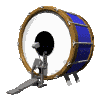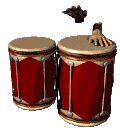



Percussion instruments probably are the oldest of all musical instruments; they are found in all cultures. They consist of membranophones, the entire family of drums that are sounded by striking or rubbing a stretched skin; and idiophones, made of such material as wood, metal, or bone, and including bells, gongs, triangles, marimbas, and wood blocks. Both types of instruments include some of definite and some of indefinite pitch, the idiophones having a greater number and variety of examples that produce definite pitch. The uses of percussion instruments have been more varied in non-Western cultures, where the tuned varieties (such as marimbas) have been used to a great extent. The Javanese and Balinese gamelan illustrates the variety and subtlety of percussion instruments in tuned concert.
The functions of percussion instruments include signaling; accompaniment of dancing or singing, especially in primitive cultures; and ensemble and orchestral use. In Europe the percussion instruments were quite limited in number until the 19th century, especialy in concert music where the timpani (kettledrums) and a few other drums were used with the triangle and cymbals. In the late 19th and 20th centuries the demand fo a variety of percussion instruments grew with the rise of program music and impressionism; gongs, castanets, and all manner of tuned percussion instruments emerged as standard instruments. The percussion ensemble is a phenonmenon of the 20th century.
Percussion instruments are essential to high school and college bands, drum and bugle corps, and dance bands and rock groups. While solo percussion compositions are rare in concert music, they are commonplace in the training literature for young players.